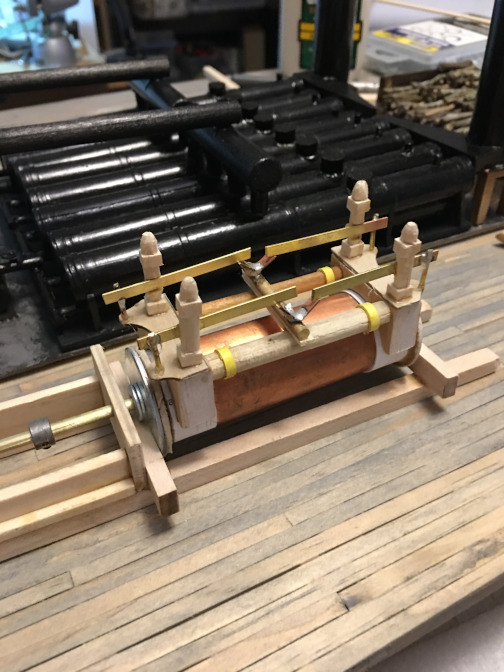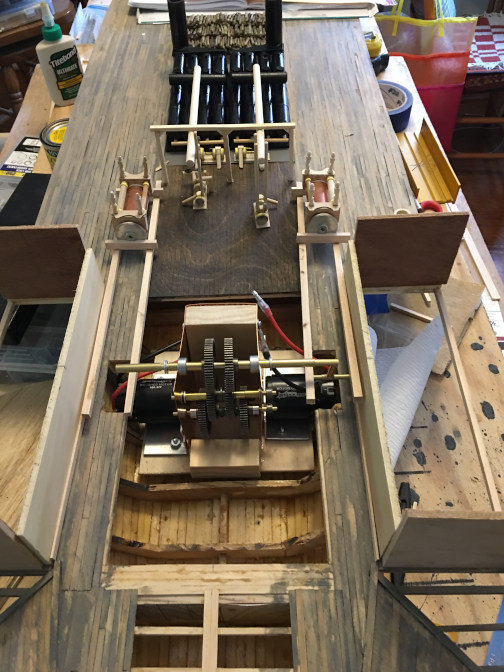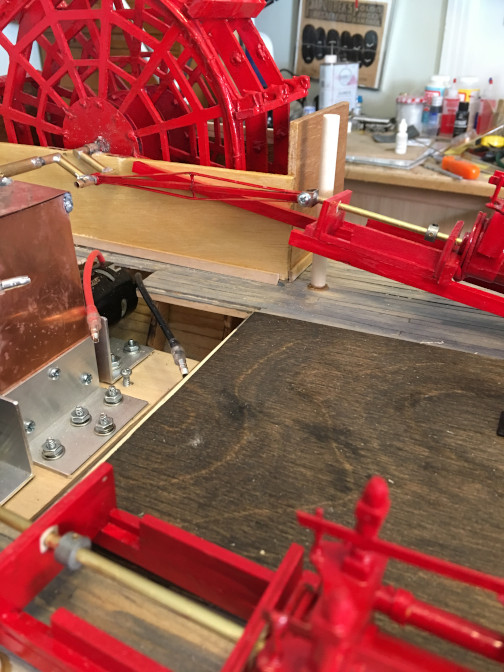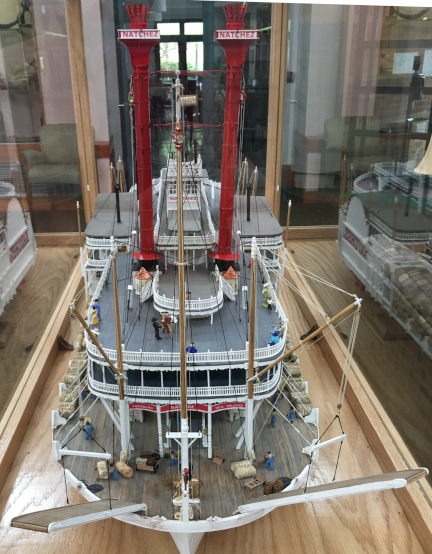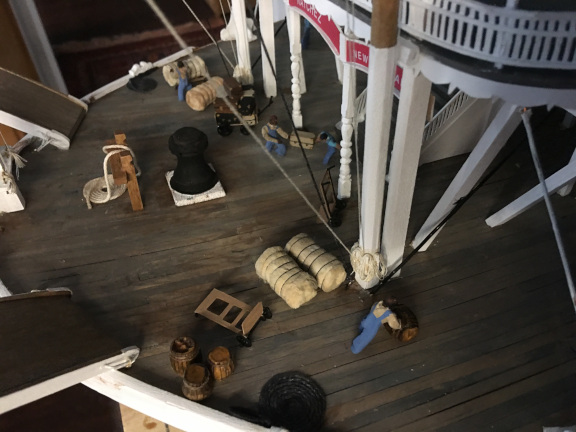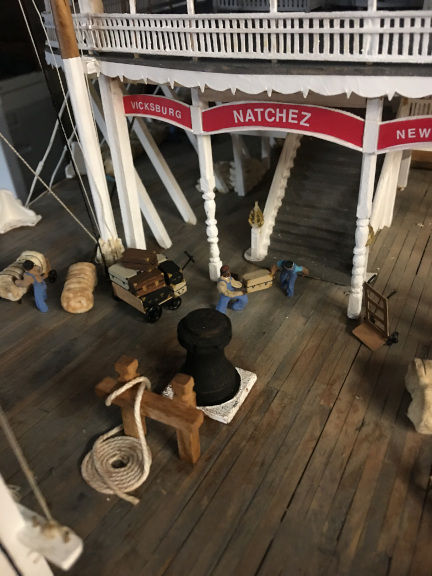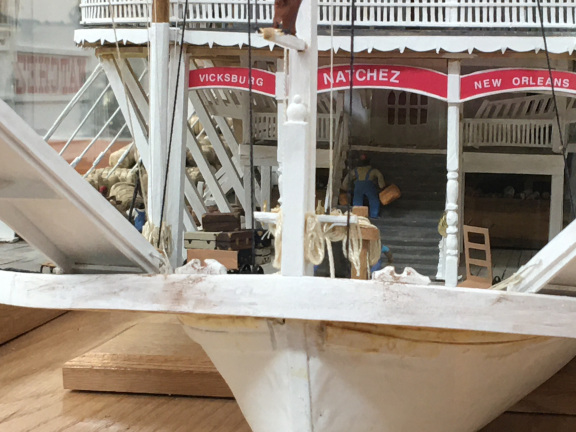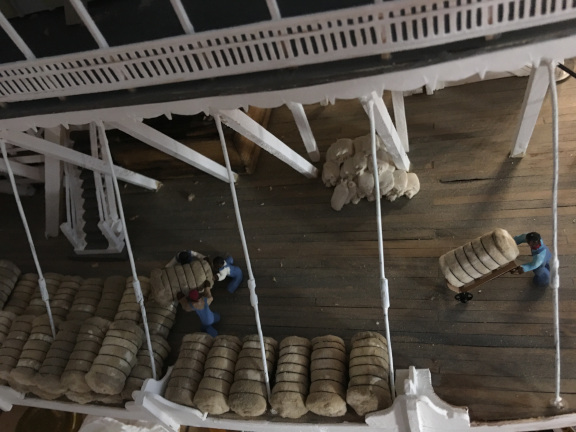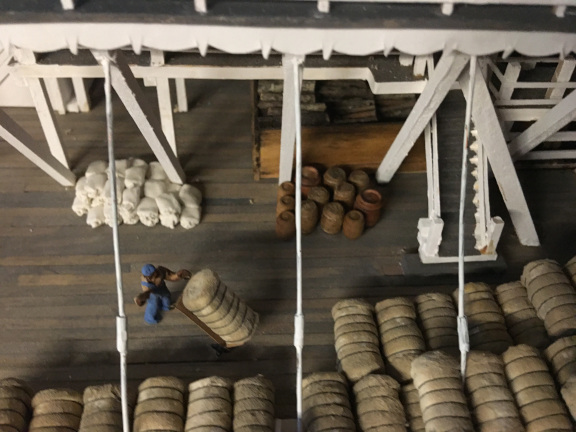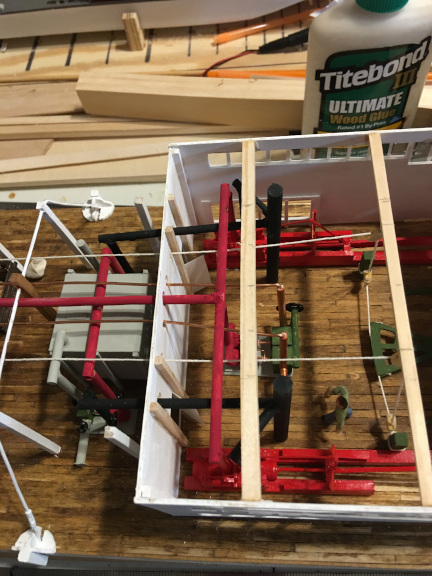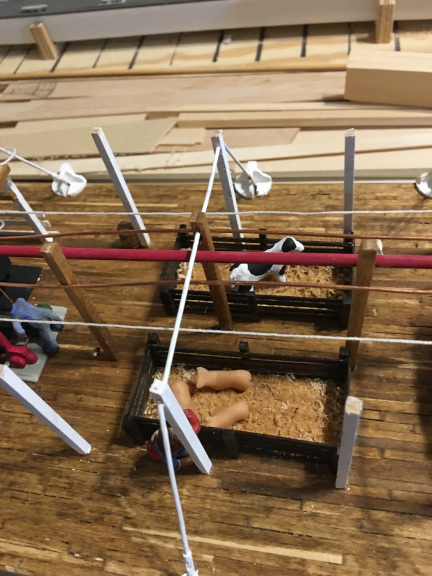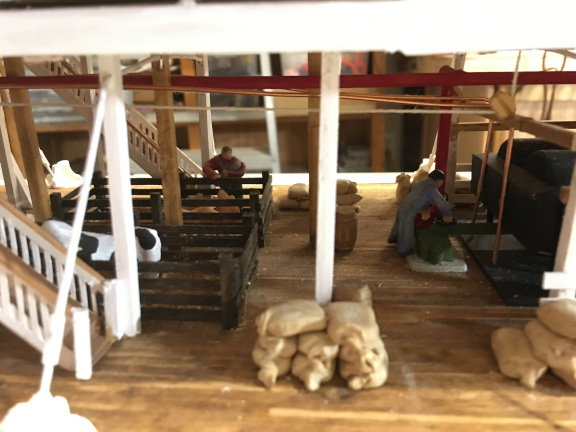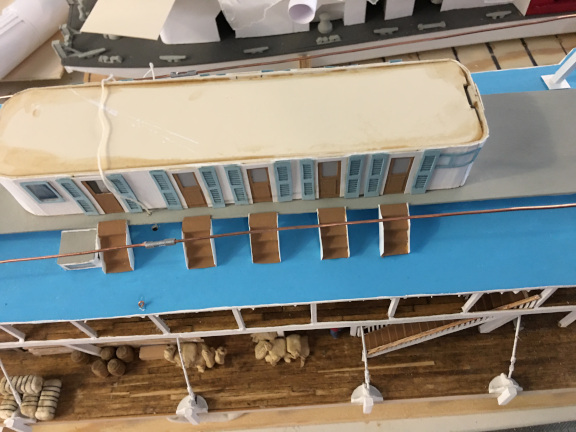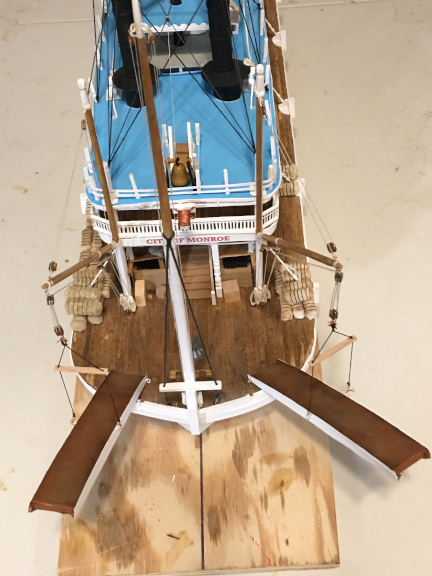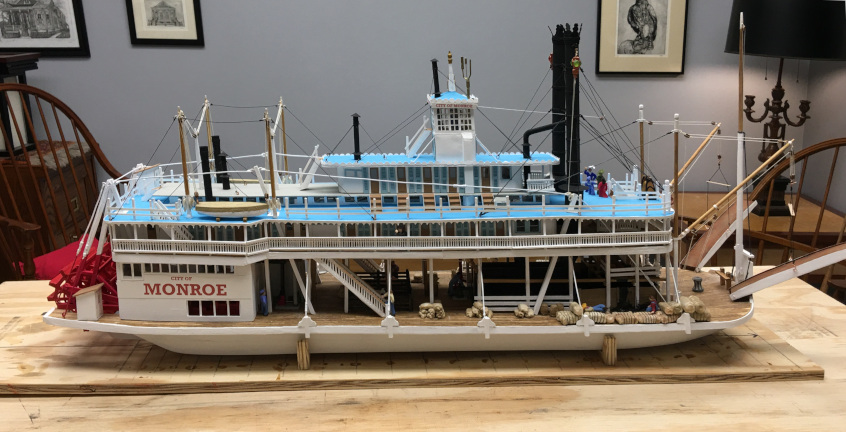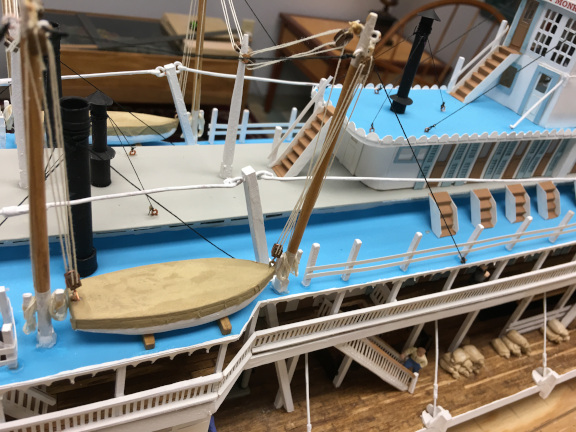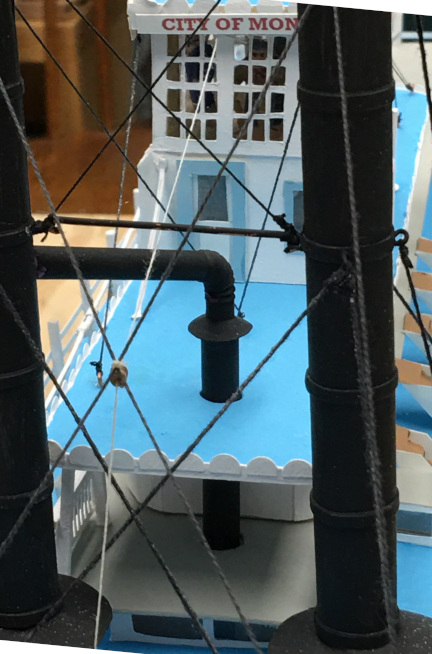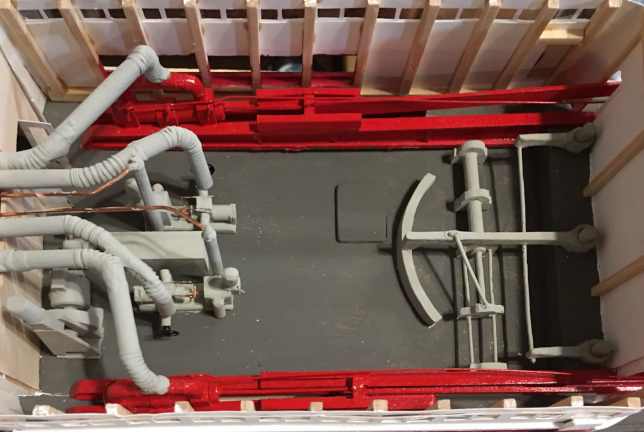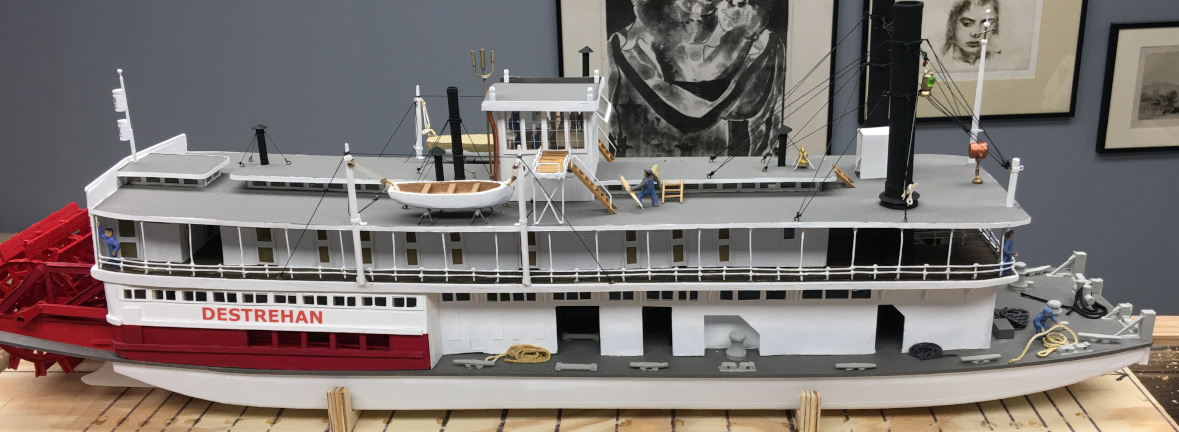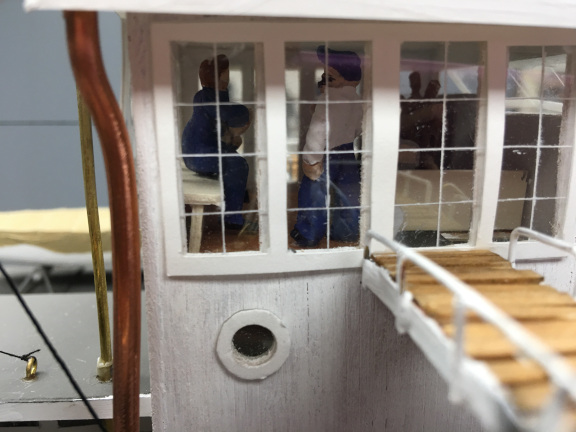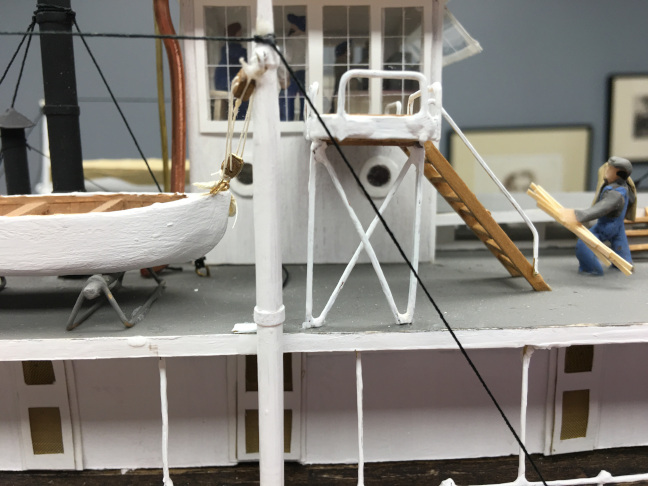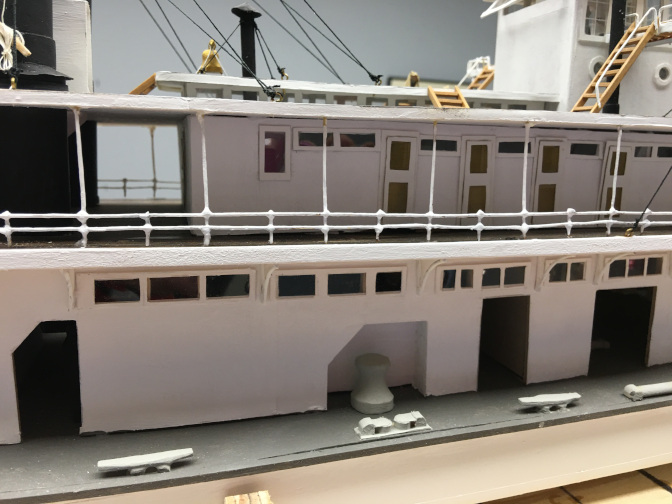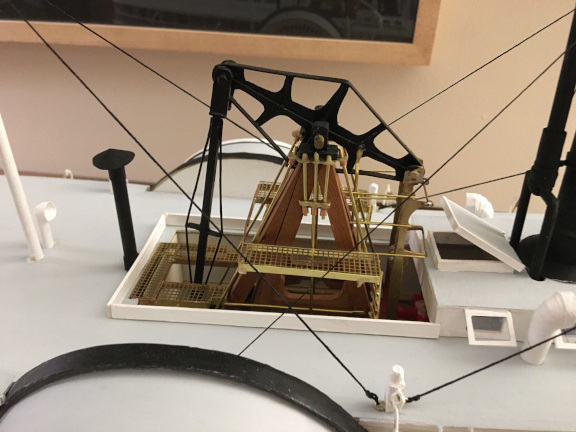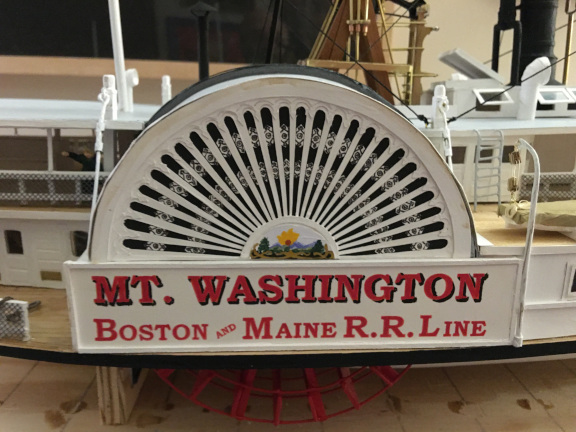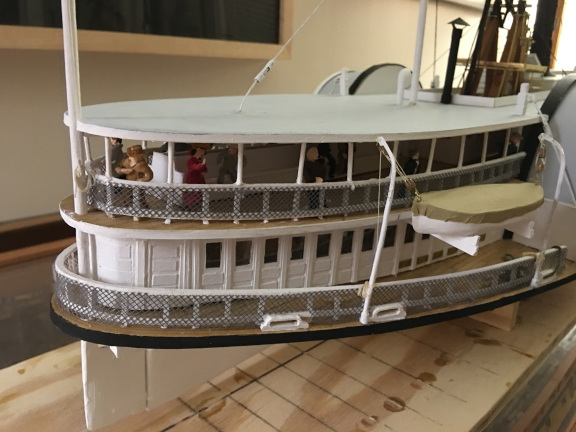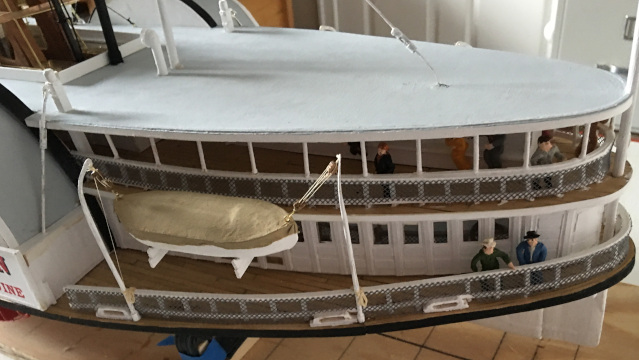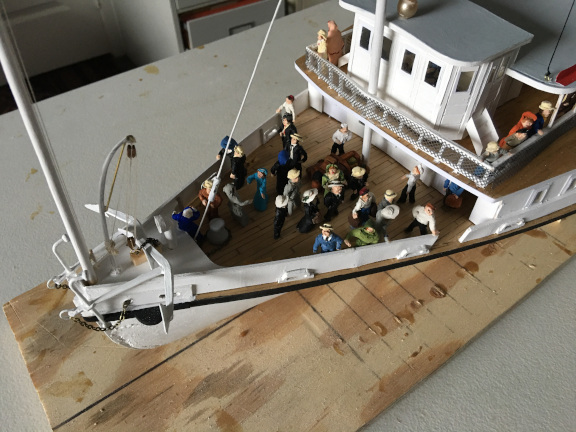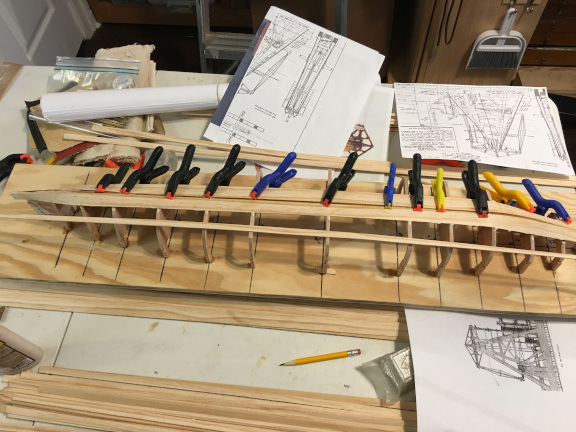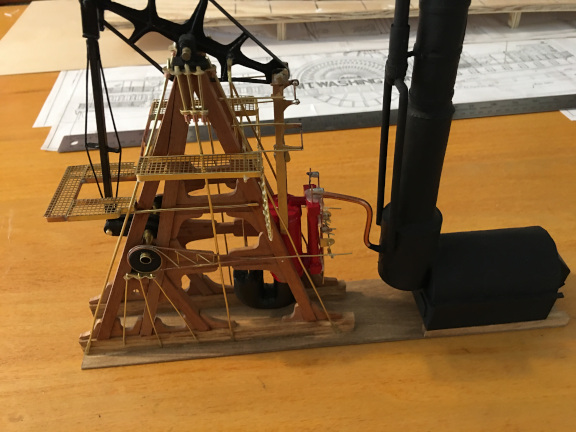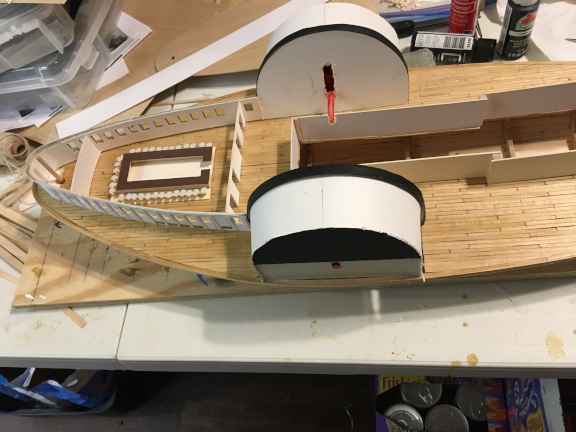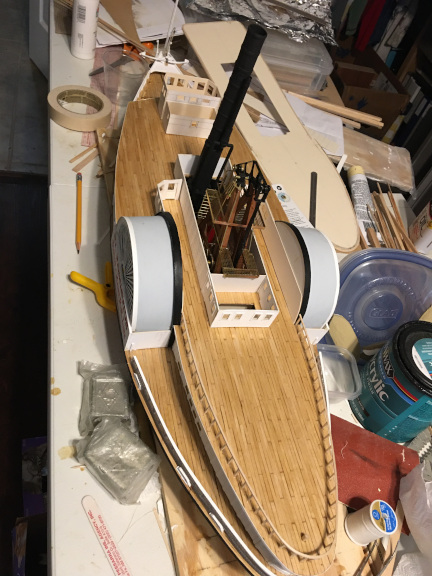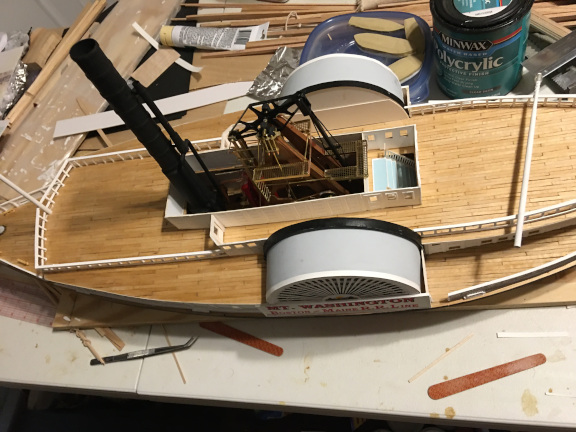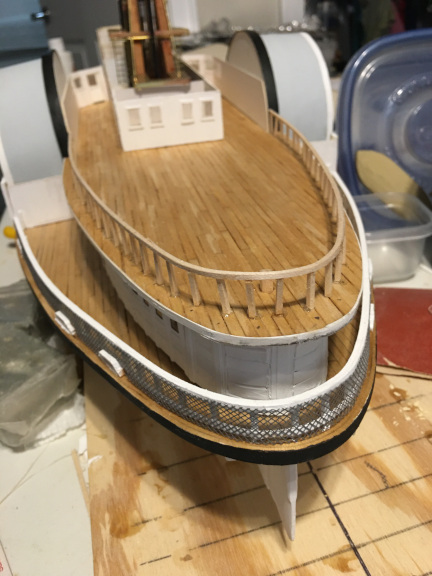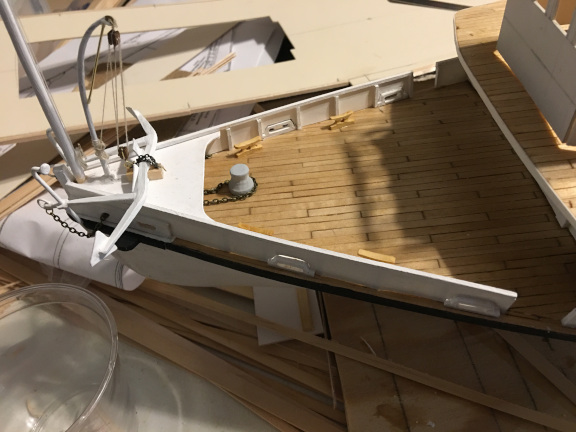Information about the Natchez here.
Information about the model of the Natchez here.
Photos of the completed model of the Natchez here.
Information about the model of the City of Monroe here.
Information about the model of towboat Destrehan (1921) here.
Information about the model of the Mount Washington (1872) here.
The Mississippi River Steamboat Natchez of 1869
There have been multiple river steamboats named Natchez, beginning with the first of
that name, a side wheeler built in New York City in 1823 for the Mississippi river trade between
Natchez, MS and New Orleans. She burned in 1825 in New Orleans.
The subsequent second through eighth boats of the name were all owned and operated by Thomas P.
Leathers, a colorful steamboat Captain with a penchant for fast boats and racing his competition.
All the boats owned by Leathers were built in Cincinnati. Each one was longer and larger then its
predecessor with increased power and speed. The Natchez of 1869, was about 301 feet long, although
accounts vary about the vessel's dimensions. She had eight boilers, two engines driving the side
paddle wheels, and a made over 400 trips between Vicksburg and New Orleans in the nearly ten years
she operated on the Mississippi in the lucrative cotton trade. Cotton carrying capacity
was 5,000 bales (each weighing about 500 pounds) and she also could accommodate several hundred
passengers. This boat is the "Natchez" which famously raced with (and lost to) the Robert E. Lee in
1870, in a race from New Orleans to St. Louis, MO.
This seventh Natchez was built of wood with iron fastenings. There was a "hog chain" system consisting
of two lengths of supporting iron running lenghwise from the front of the vessel to the back, held
aloft by large timbers to counteract the tendency of such a long vessel to sag at the fore and
after ends, where buoyancy was less than in the middle where the hull was wider and deeper. In addition,
there were two masssive "cross chains" running athwartships from the outer edges of the two wheel
guard-timbers up and over two "Sampson posts" in the middle of the hull extending above the highest
roof of the cabin. This latter system supported the beams that carried the outer bearings for the
shafts of the paddle wheels.
She was scrapped in 1879, when the successor Natchez was launched.
The eighth Natchez (1879), was also captained by Leathers, but the Mississippi cotton trade
was diminishing and she was built as an elegant passenger vessel with 47 staterooms. This vessel
had eight boilers and thirteen engines. She was 303 feet long with beam of 45 feet and 10 foot
draft. She burned in 1889 and by that time, Leathers felt he was too old to build another Natchez,
and with the steamboat industry starting to decline, he decided to retire.
After retiremnt, Leathers divided his time between his Garden District home in New Orleans and his
Natchez home,"Myrtle Terrace". He was killed in 1896 at the age of 80 when struck by a bicyclist while
walking along St. Charles Avenue in New Orleans.
The present day Natchez, (Natchez IX), operates as an excursion boat in New Orleans. She is the
ninth steamboat of that name and was built in Braithwaite, LA, in 1975 of steel construction as a
sternwheeler. She is 265 feet long, 46 feet wide, with draft of six feet and weight of 1384 tons.
She has oil-fired boilers generating the steam to operate the two engines, which date from 1825
and were originally in the towing vessel Clairton, owned and operated by the U. S. Steel Corporation,
which had purchased the Clairton Steel Company in 1904.Clairton, PA, is about
20 miles south of Pittsburgh on the Monongahela River. U.S. Steel also owned the Pittsburgh Steamship
Company, operating the largest commercial fleet on the Great Lakes in the early part of the 20th
century.
There was also an earlier Natchez IX in the 1890s owned and operated by Bowling S. Leathers, son of
Thomas P. Leathers, and his wife, Blanche Douglass Leathers. Blanche later became the first female
licensed Mississippi River Captain, operating a packet steamship between New Orleans and Vicksburg.
Her vessel is sometimes referred to as Natchez X, to distinguish it from the current Natchez.
Building the Model of Natchez in 1:64 Scale
I originallyl intended to build a 1:64 (3/16" = 1') scale model of the Natchez V! as a radio-controlled
model for operation on Bayou St. John, near our home. As the model progressed, however, I changed the
plan for several reasons. I felt that the configuration of the hull (displacement) would not
provide enough buoyancy for the probable weight of the model once batteries and motors were installed, and
as the model progressed, it became more and more elaborate and I did not want to risk running it
on the bayou.
I did build a gearbox to drive the paddle wheels (independently) and did several dry runs to check that
they were operating well, but when I converted to a static model, I removed all batteries and left the
motors, speed controllers and receiver in place in case my plans changed later. I had also installed
extensive LED lighting in the various cabins and outside areas powered by separate batteries from the
motor batteries. The lights operated independently from the drive train and were controlled by small
toggle switches at the after end of the lower cabin. When I ultimately decided to put the model
in a display case in a public area, I removed those batteries also.
I built the model using very extensive plans by Mr. Bernd Lorenzen in 1:96th scale (1/8" = 1') by
converting the plans to 1:64 scale with a photocopier. These are excellent plans and are still
partially conjectural, as no plans and scant photographic documentation exist of the original vessel.
Still, using knowledge of practices of the time, the plans are as good as one can get.
Here are some photos of the model under construction. The hull was built using 1/4" plywood
bulkheads planked with pine strips 1/16" thick. The planking was sealed with waterproof glue
and given about 6 coats of spar varnish before painting.
Here are some photos of the hull build, starting with setting up the bulkheads on
a building board, then planking the hull.
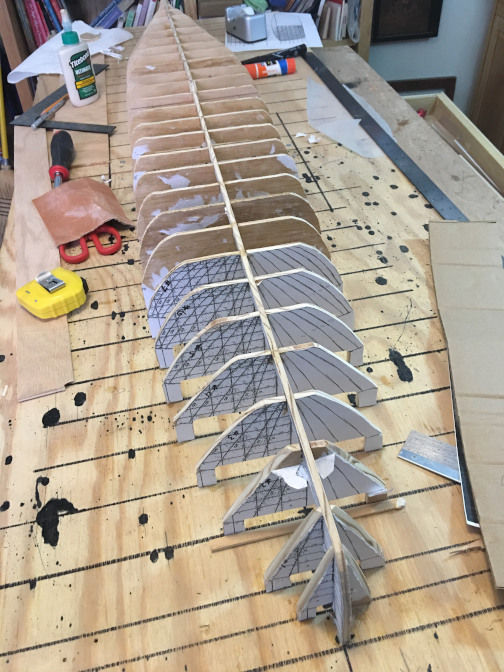
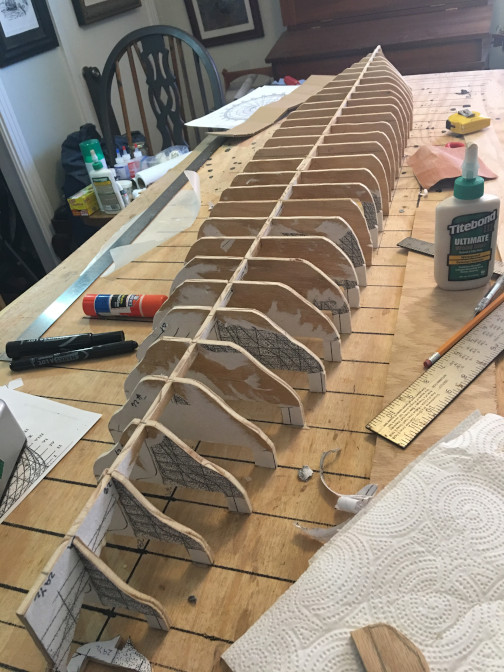
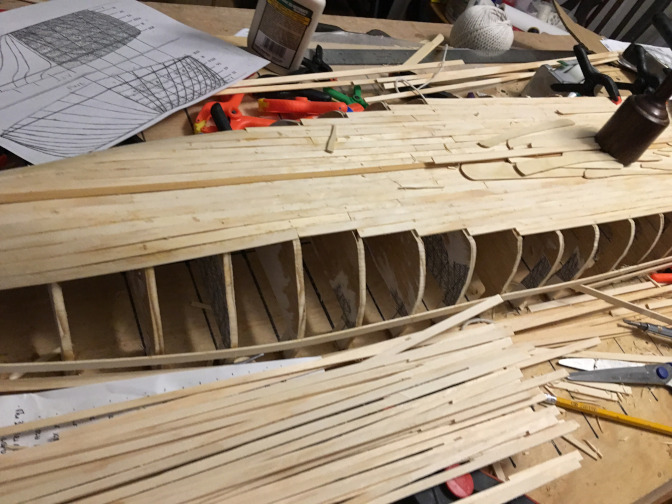

The paddle wheels were next, as they had to be correct in size to fit in the areas of the hull
devoted to them and also determined the size and location of the driving gears and motors. I reduced
the number of spokes on each wheel from 25 to 12 because I felt, with no evidence, that they might
function better in the operating model. Besides, it was easier to make wheels with fewer spokes.
I built them over a core of copper discs reinforced with steel washers and the rims of each wheel were
reinforced with heavy gauge copper wire soldered into a circle. The wheels were epoxied to the
wire rims and the spokes epoxied to the center section and the paddle boards were epoxied to the spokes,
all with marine epoxy reinforded with 28 gauge brass wire. Then the wheels were soldered to a
3/16" solid brass axle. Each wheel has a crank, fabricated from brass tubing and rod, and the cranks
in turn were linked to each of the separate engines as shown in the photos. The crank shafts
extended into the gearbox, where it was driven through reduction gearing by electric motors, each
shaft operating separately.

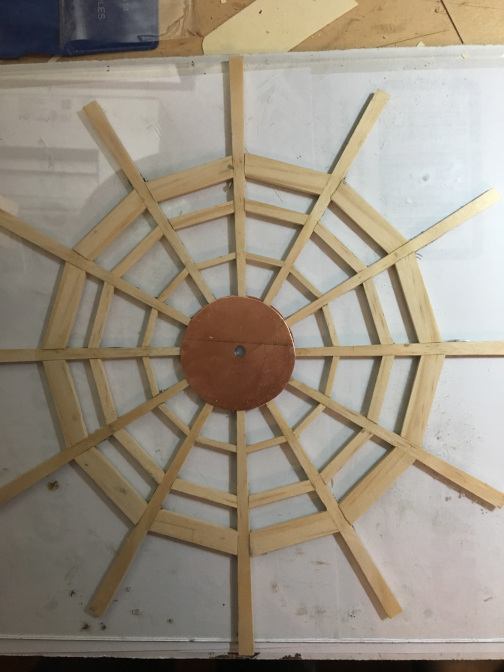
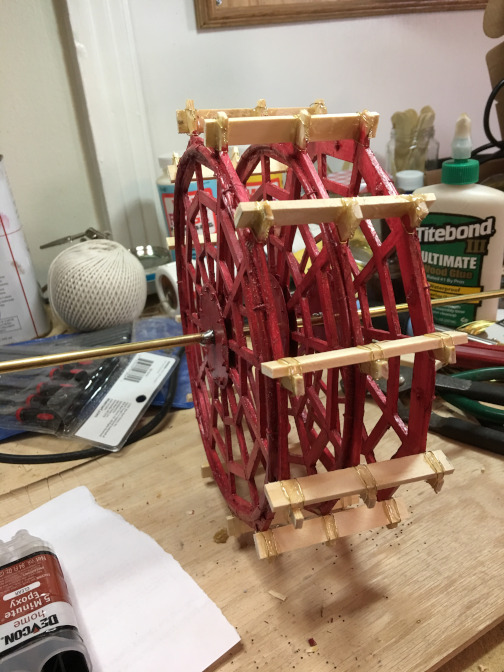

Once the paddle wheels were done, the main deck beams could be installed, and the deck was planked
with pine strips about 1/8" wide, leaving
openings for access to batteries, motors, gearbox, and so forth. The openings foward for the batteries
are covered with a panel that is the base for the cordwood fuel storage and the boilers. The motors are
attached directly to the gearbox, which is necessarily in line with the axles of the paddle wheels.

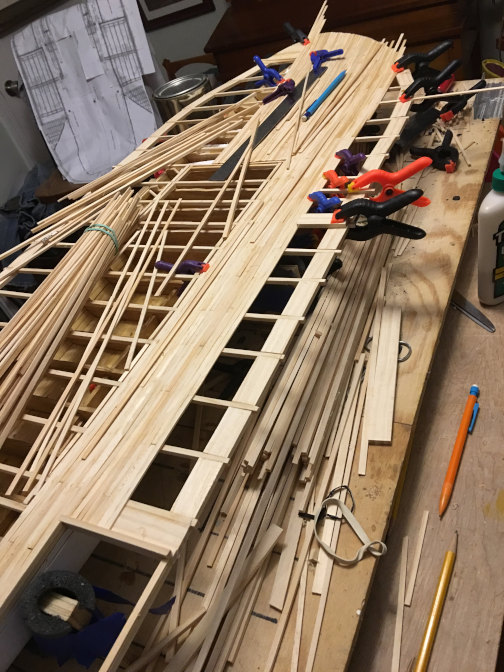

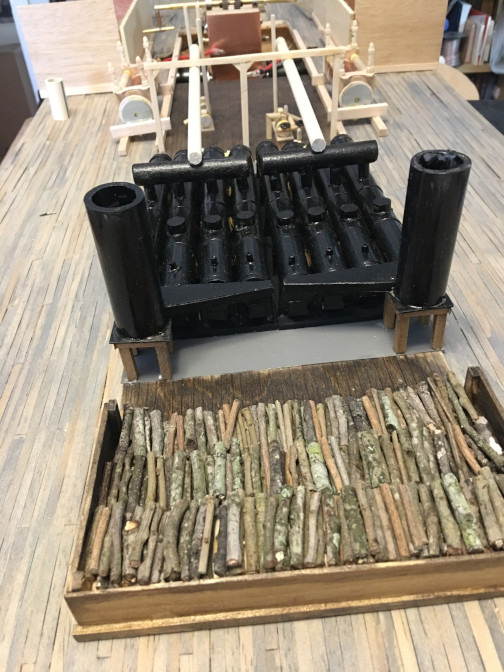
The engines are made up of copper pipe, various carved wood pieces, brass and copper sheet and
tubing. Each "piston rod" leads to a crosshead where it hooks up to a connecting shaft which
is in turn connected to the paddle wheel shaft crank. Thus, when the motors drive the paddle wheels,
the cranks also drive the piston rods in and out of the engines.
Once the drive train was fabricated and installed, and the inner sides of the wheel houses constructed, the rest
of the job was just regular scale model building. There is a barricade deck, a deck halfway between
the main deck and the boiler deck in the front half of the hull where there was a reception
area and baggage storage. Then, the boiler deck with staterooms, a central hall, various service
and support areas and so forth. Above are the crews quarters, on top of the skylight for the
central hall of the passenger area. Below are pictures of the work in progress that illustrate
the stages of construction.
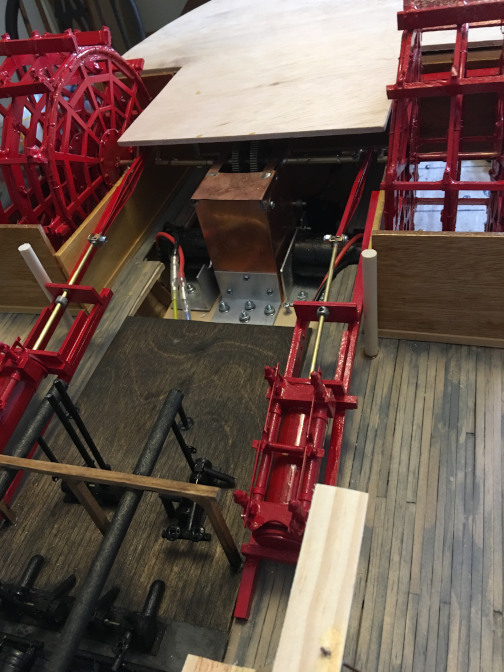

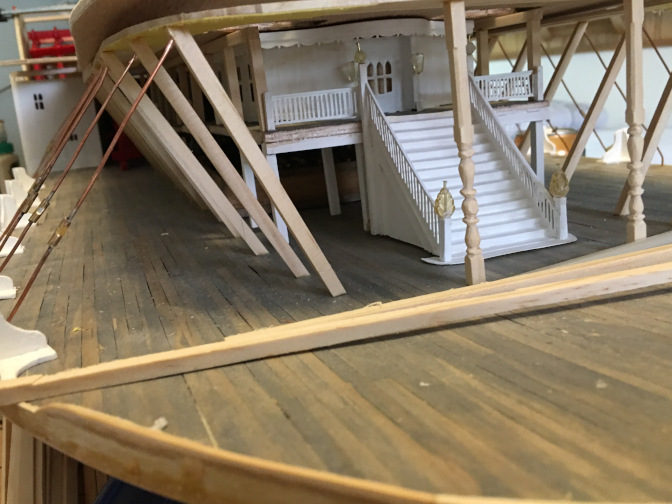
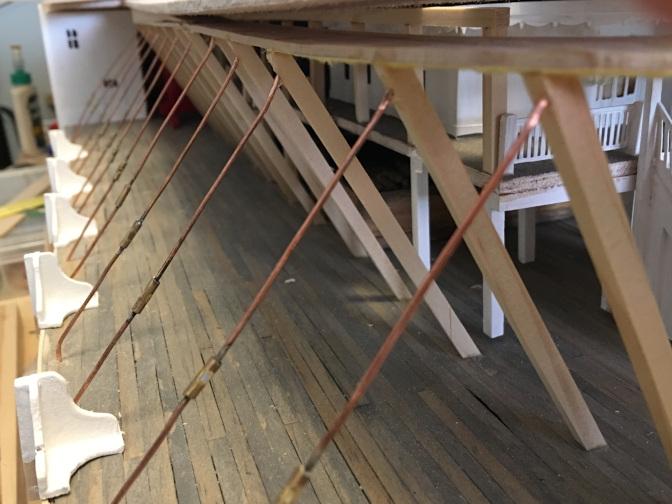
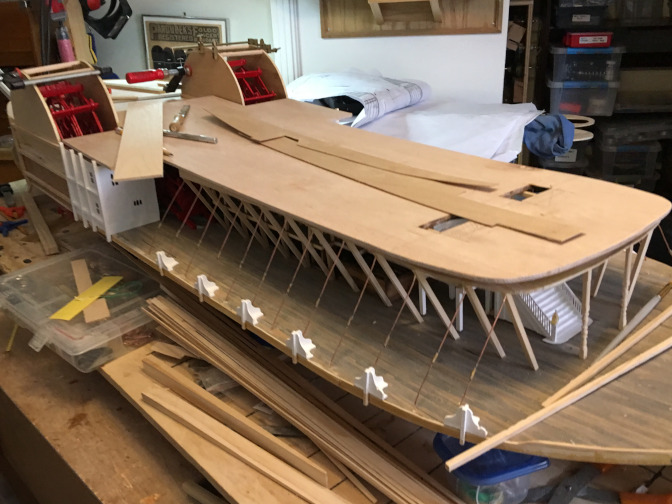
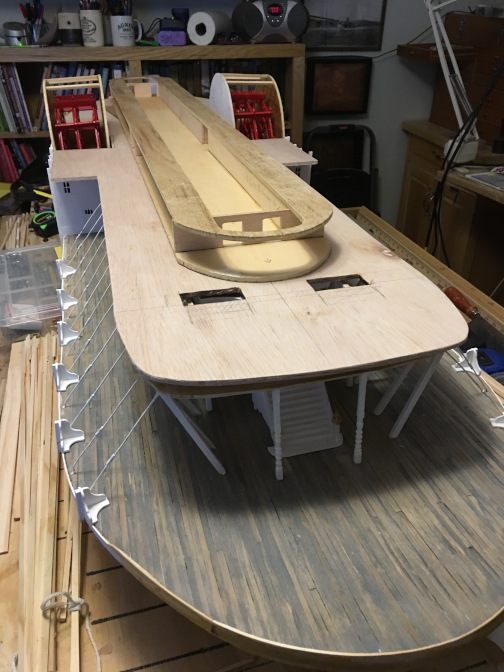

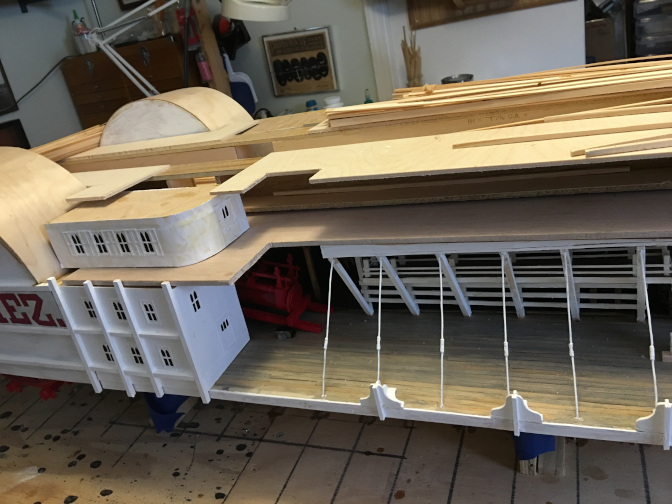
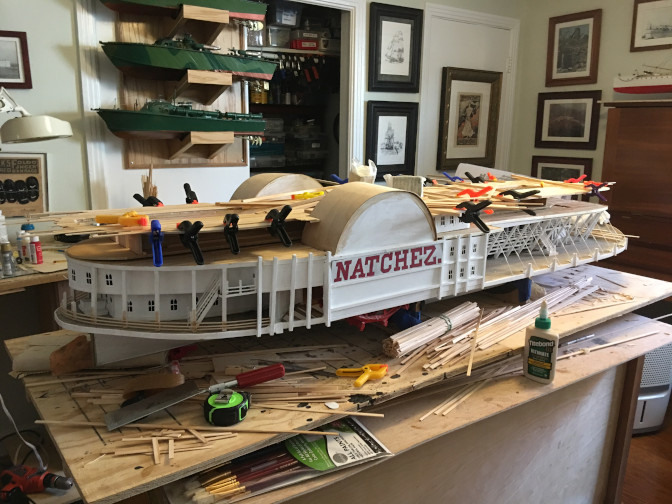
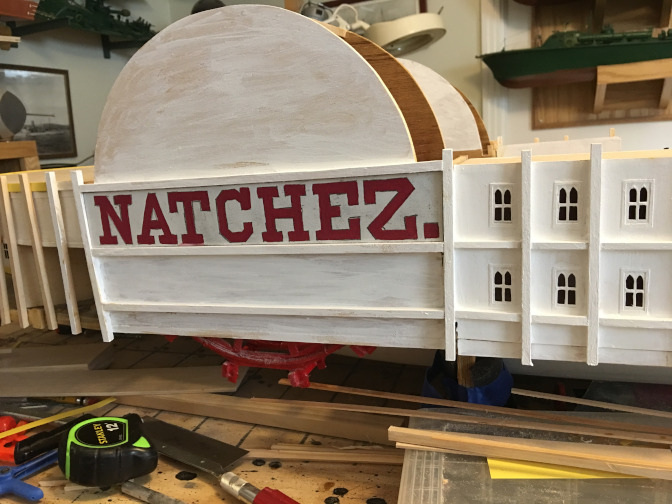
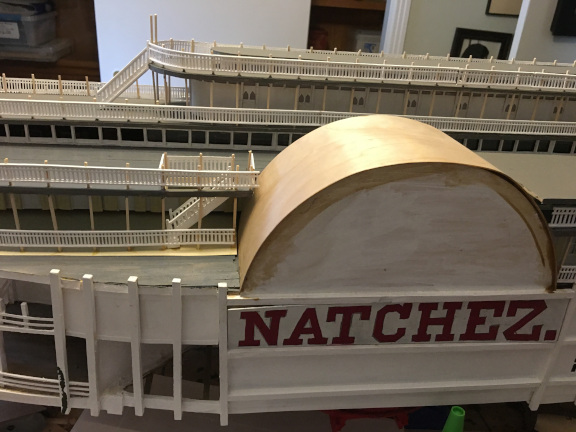


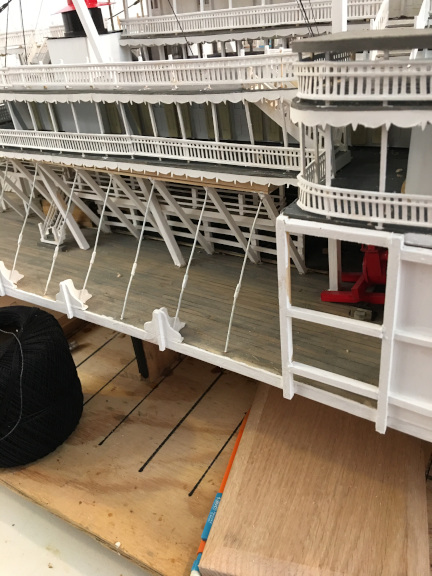

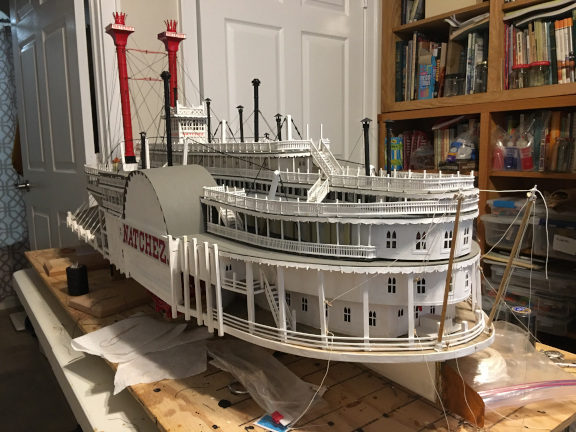

I also made about 350 mineature cotton bales, and a couple dozen passengers and crew, mostly to give
a viewer some sense of the size of this vessel. In the end, Natchez ended up in a case in the
lobby of our home at that time, a retirement community, Woldenberg Village, on the "West Bank"
of New Orleans. However, we left that community in 2022 and moved back into the city proper, in
the "Bywater" neighborhood, and sold the Natchez, the City of Monroe, Destrehan, and the dioramas
of whale ship Daisy and her whale boat at that time. The Mount Washington also found a new home,
in New Hampshire, close to the mountain for which she was named.
The model of the City of Monroe
This model is also in 1:64 scale and was built by adapting a set of plans
by James Hale, from 1975. Mr. Hale is an authority on steamboats of the late
nineteenth century and created his plans to build a 1:32 scale model for radio
controlled operation. The development of the plans and the building of his
model are described in his article about the building of the City of Monroe in
Nautical Research Journal, December 1975, Vol. 21 No. 4, p.173-178.
Mr. Hale's intent was to create a conjectural plan for a small steam
packet which might have worked on the smaller tributaries of the Mississippi
in the late 1800s. He states that his plan was based on the much larger
steamboat, America, about 275 feet long, but reduced in size to the
equivalent of about 175 feet long. He chose 1880 as a theoretical construction
date and based the drive train on contemporary practices.
The choice of name may be a bit unfortunate, however, as there was a real
steamboat named "The City of Monroe", but it was a much larger (over 300 feet long) side wheeler,
said at the time of its construction (1890) to be the largest steamboat on the river.
It was one of the approximately ten large and luxurious steamboats built for the Anchor Line,
which was perhaps the dominant company operating multiple steamboats on the Mississippi from
just after the Civil War until the collapse of the steamboat industry in the latter 1890s.
Anchor Line named its vessels for cities and operated the "City of New Orleans", "City of Vicksburg",
"Belle Memphis", "City of Cairo", "City of Baton Rouge", and more.
This is most definitely not a model of the "real" City of Monroe.
This model is in 1:64 scale. Since the original Hale plans were conjectural, I did not hesitate to have
some fun and make some changes as I built her. I imagined the vessel as she might have looked with a mixed
cargo of cotton from small producers, general freight, baggage, livestock, and passengers.
The plans called for two boilers providing steam to two engines driving a single stern wheel.
The cylinders of the engines were much smaller diameter than on the Natchez (1869) or the Mount Washington (1872)
although the stroke remained long (about 10 feet). The smaller cylinders may reflect the improvements in steam
engine design related to the railroad locomotive development of the era, and are similar in size to those of the
Destrehan (1921). At any rate, it was a fun build.
There is also a real Louisiana city named Monroe, located on the Ouachita River, a tributary of the Mississippi.
It was named for a steamboat, not the other way around, when the "James Monroe", which was the first steamboat
to call on the city, then named Fort Miro, sometime in the 1840s. The populace was so impressed by the new-fangled boat,
and the promise that the small settlement would thenceforth be connected to the world at large that they re-named
the town Monroe, in honor of the boat.
The hull was made up using 3/16" plywood for bulkheads, derived from the lines on the hull plan, planked with
1/6" basswood sheet and planking. I built the hull for City of Monroe and the hull for Destrehan at the same
time. I alternated working on the two models which were side by side on the work table, decking both, building
cabins and superstructures, building and installing boilers, engines, paddle wheels and so forth pretty much
in parallel. When it got to the final building and detailing and finishing of the models, I worked on City of
Monroe to complete before completing Destrehan.
Therefore, some of the photos will show both vessels in progress. There is great efficiency in doing multiple
copies of a sub assembly, such as engines or wheels in a steamboat. Something I learned when doing the
PT boat series, when making sixteen torpedo tubes at the same time, for example.
This first series will be mostly of the City of Monroe. Pictures of the Destrehan will show more comparisons
of the two vessels, as the drive chain for the tow boat was markedly more robust than that for the
steam packet.
The City of Monroe was coal-fired, so the main engine deck had bins for the storage of coal, and
the vessel had coal dump scuttles on that deck also. There was a barricade deck, halfway between
the main deck and the boiler deck, and, as on Natchez. That was where luggage was stored, though
she lacked the reception room and other features of the larger boat, as the "grand staircase" was
a more modest affair that lead directly to the boiler deck and entrance to the few staterooms on that deck.

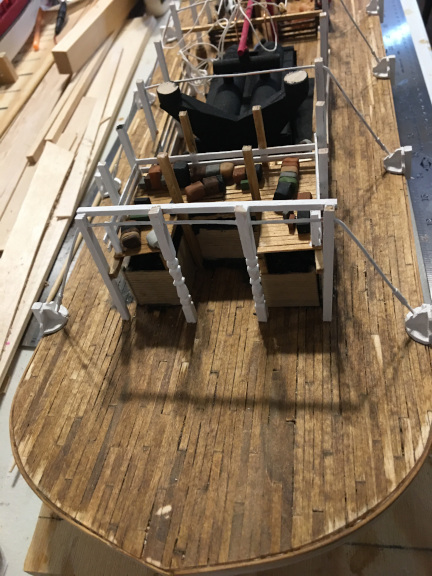
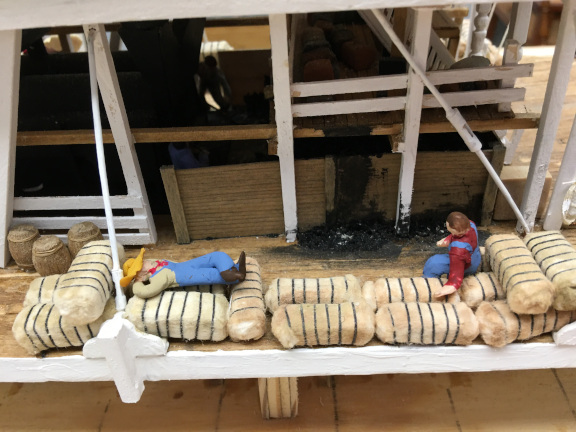
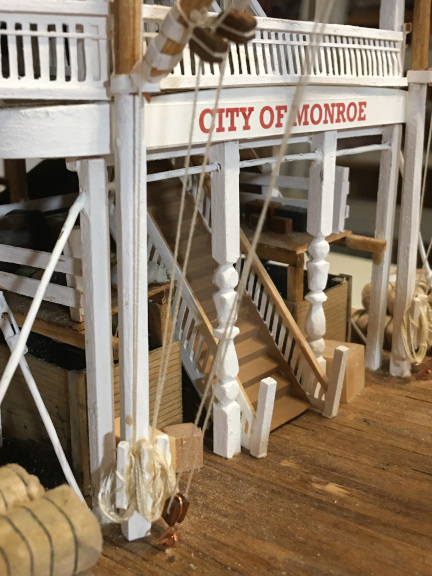
Here are a couple photos of the engine room. There is a large water storage tank at
the forward end of the engine room. Also in the engine room is the rudder control
mechanism. This model has three rudders, linked together, with the central rudder
having a quadrant which is moved through a rope and pulley system much as ships had
used for a century or more. The ropes passed along the bottom of the boiler deck
forward then up to a large drum connected to the large steering wheel. The steering
mechanism for Natchez is similar, but the Destrehan system is very different.
Following are some pictures of the construction of the Monroe. There are a few
shots of the livestock pen, one of the various items of "cargo" made for the
main deck, and pictures of the constuction of the lobby/reception area and the
staterooms. There was even a small bar for the gentlemen.
The last pictures are of the completed model.
Photos of the completed model
Modeling the Mississippi River Towboat Destrehan (1921)
This model is also in 1:64 scale and is built from copies of original blueprints from the
company that built the original vessel. The boat is a towboat, designed to push large
barges along the Mississippi River carrying bulk cargo, such as coal or oil.
Because this vessel pushed such large cargo-carrying barges, it was especially robust, with
a steel hull, four oil-fired boilers, and a particularly heavily built stern paddle wheel.
Destrehan was built in 1921 by the Charles Ward company in Charleston West Virginia for the
Pan American Petroleum company of New Orleans. The vessel was primarily used to transport
barges of oil and refined oil products up and down the Mississippi based in New Orleans.
She was sold in 1941 to the American Rolling Mill Company, renamed the Charles R. Hook, and
based in Cincinnati, Ohio. She then transported barges between Cincinnati and Huntington on the
Ohio River. The American Rolling Mill Company operated a small fleet of steam-powered towboats
on the Ohio River and West Virginia's Kanawha River pushing barges from the coal mines of West
Virginia to its Ashland, Kentucky plant or Cincinnati where the coal was transported by train
to the Middletown plant.
Dismantled in 1957, The towboat was re-modeled by a locally renowned riverboat captain, Jack Beatty,
and reincarnated as a floating restaurant, the "Captain Hook", which opened in 1964 in Cincinnati.
I do not know its ultimate fate.
The model of the Destrehan was built simultaneously with the model of the City of Monroe, in the same scale.
It was instructive to be able to compare the two vessels. Although the engine cylinders were not
much different in size between the two, everything else was larger - the boilers, the steam pipes,
the paddle wheel.
Following are a few pictures comparing the two models in progress to highlight these differences.
In addition, since the Destrehan was oil-fired, the fuel was stored below deck in huge tanks rather
than in bins on deck as for the City of Monroe or the Natchez. The first two show the paddle wheels
in progress, the Monroe components (4) on the left, the Destrehan, with 5 wheels on the right. Then there
is a picture of the drive trains of the two vessels for comparison, Monroe above, Destrehan below. And
the last picture shows the drive trains installed in their respective hulls.




Two photos of the engine room to show overall layout and some detail of the
multiple steam powered auxilary motors, electric generator, and communication console.
The triple rudders, also linked together,are now controlled by a steam powered cylinder
linked to the center rudder arm and controlled from the pilot house by a steam line.
Construction of the crew quarters on the second level. The cabins are larger than on
earlier steamboats and there is a separate after cabin containing showers and storage.
The first picture shows the layout of the cabins with the roof, containing a central
skylight, shown above the cabins. The second picture shows the roof completed lying
in front of the cabins.
Photos of the completed model.
The Winnipesaukee Steamboat Mount Washington (1872)
The original Mount Washington was an excursion boat sailing in the summers on New Hampshire’s
Lake Winnipesaukee.
The first Mount Washington known as "The Old Mount" to locals, was a wooden-hulled steam powered
side wheeler
built in 1872 in Alton Bay, NH. This first Mount Washington was 187 feet long, with a beam
of 49 feet driven by a single cylinder walking beam steam engine of 450 horsepower
that operated at approximately 26 RPM.
She was built for the Boston and Main Railroad to transport cargo and passengers around the lake
during the summer season and to promote tourist use of the railroad passenger service.
In the 1920s, with declining passenger train usage, the Boston and Maine Railroad Co. sold the steamer to
Captain Leander Lavallee. Lavallee operated the Mount as a tourist attraction, still drawing crowds
of over 60,000 a season.
Because Lake Winnipesaukee freezes over solidly in the winter, the vessel was stored in a winter
dock in Wiers Beach ("The Wiers"), NH. The water was kept from freezing around the hull by aeration, with
a marine railway used to haul the boat onto shore if the water began to freeze. On December 23, 1939,
the ship burned at her winter dock when a fire on the land spread to the dock and the ship. The fire
happened at night, and the vessel was lodged solidly in the mud of the bottom, so she could not be hauled
to safety.
Shortly afterward, a local company planned a replacement. Steel shortages from the war in
Europe prevented new construction of a steel hull and resulted in the purchase of the Chateaugay (203 feet),
a iron-hull sidewheeler. The ship
was cut apart and transported to the lake by rail where it was converted to a screw-driven steam powered vessel
in Lakeport, NH. Her maiden voyage was in August of 1940.
Since then the current Mount Washington ("M/V Mount Washington")has undergone conversion
to diesel power and extensive modifications to the hull which has been enlarged and made more luxurious.
She still operates in summers on Lake Winnipesaukee.
This model is of the Old Mount as she might have looked in the early 1900s, while still owned and
operated by the Boston and Maine Railroad. Photo documentation from that time show the vessel crowded
with passengers, and that is how she is modeled.
Following are some pictures of the finished model, then some of the work in progress.
Some pictures of the model in progress.
The boiler and engine were fabricated of brass, copper, wood and cardstock as a
first step after the hull was planked. The engine/boiler assembly was then fitted
to the hull and the superstructure build around it.












